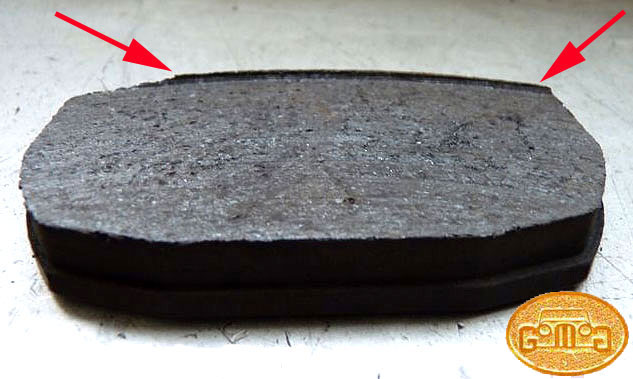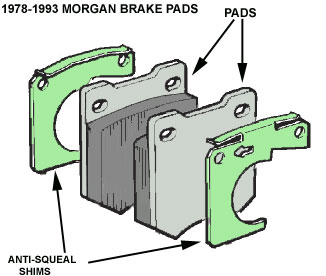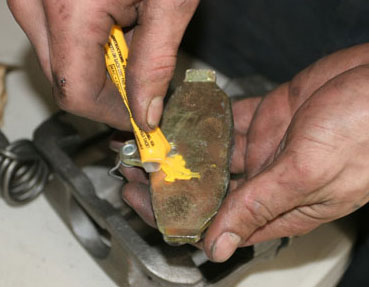Dealing with Brake Squeal (calipers)
Lorne Goldman
Disk brake squeal is caused by the brake pads vibrating
when light to moderate brake pressure is applied. Heavy braking usually
stops squeal because the extra pressure dampens the vibration. If heavy
braking doesn't stop the squealing, it's a sign of a more significant problem.
Squealing under light braking isn't a safety concern, it's just damn annoying.
When squealing occurs, it's usually the leading edge of
the brake pad that is in contact with the rotor, causing a twisting force
on the pad that makes the trailing edge want to lift away from the rotor.
PREVENTIVE MEASURES WHEN INSTALLING NEW PADS:
Pad compound is a big factor with squealing. For example,
I have found that Porterfield
R4-S braking compound, along with other potent benefits, end brake
squealing on a Morgan, without the use of any other aids. I use the compound
on my pads and rear shoes.
When installing new pads, make sure that they fit with
a tiny little bit of clearance in the frame. I chamfer the edges of the
pads and shoes on installation. I make it a rule to change Morgan
pads and rotors at the same time. Don't try to save money with brakes.
 WATCHPOINT:
In 2008, the Morgan Motor Company moved to new 4-pot brake calipers,
also supplied by Caparo. In 2011 I decided to upgrade one of my Plus 8s
(a 1990) from the earlier 2 pot calipers (1978-1993) to these 4 pot calipers.
I leap-frogged the calipers used from 1993-2008. The new calipers will
fit, with some fiddling and a small washer/spacer. They also use the same
pads as the 1993-2008s. However, there is a watchpoint. Caparo said that
they did not receive any feedback from the Morgan Motor Company and the
pads sit proud of the rotor. Over time, a thin lip is formed, getting ever
deeper with usage. This caused concern to the Caparo engineers. WATCHPOINT:
In 2008, the Morgan Motor Company moved to new 4-pot brake calipers,
also supplied by Caparo. In 2011 I decided to upgrade one of my Plus 8s
(a 1990) from the earlier 2 pot calipers (1978-1993) to these 4 pot calipers.
I leap-frogged the calipers used from 1993-2008. The new calipers will
fit, with some fiddling and a small washer/spacer. They also use the same
pads as the 1993-2008s. However, there is a watchpoint. Caparo said that
they did not receive any feedback from the Morgan Motor Company and the
pads sit proud of the rotor. Over time, a thin lip is formed, getting ever
deeper with usage. This caused concern to the Caparo engineers.
However, we checked with the Factory and they say they
chamfer that edge at first service or the pads checked to see whether the
issue has been addressed since 2011. This task should be added to first
service on all new cars after 2008. Chamfering pads (and shoes) is not
a rare task on any car with a savvy owner. It reduces the possiblity of
a piece of breaking materiel cracking off the sharp edge and causing mischief
and noise. When I left Caparo, they hoped to receive instructions from
Morgan to adjust the dimensions of the pads they provide and eliminate
this problem but I have had no word since then. |
Hold the backing (aka squeal plate next to the pad that
is being replaced. If a new pad has significantly more clearance (so that
it will fit looser), I would probably send it back. If it fits too tight,
a chamfer bit off the edges of the backing plate with a file can
help (particularly if the tightness is due to a sharp edge left from the
stamping  process).
Again, use the old pads for a comparison of the outline.
process).
Again, use the old pads for a comparison of the outline.
 I
also liberally use an anti-squeal compound on the anti-squeal plate or
the back of the pads. You can get buy it at any automobile supply store,
Halfords, Autozone, NAPA... Comes in all sorts of colors. (smile) NAPA
also sells anti-squeal shims with an adhesive backing that stick to the
back side of the brake pads. These reputedly work much better than the
spray or brush on anti-squeal coatings.
I
also liberally use an anti-squeal compound on the anti-squeal plate or
the back of the pads. You can get buy it at any automobile supply store,
Halfords, Autozone, NAPA... Comes in all sorts of colors. (smile) NAPA
also sells anti-squeal shims with an adhesive backing that stick to the
back side of the brake pads. These reputedly work much better than the
spray or brush on anti-squeal coatings.
CHECK THE CALIPERS: The main thing is to make sure
they slide freely on the guide pins, and that the piston moves smoothly
when pressed back in. If not, fix the problem. If the pins need to be regreased,
completely clean out all traces of the old grease before applying the new.
This will prevent compatibility problems. Also make sure that none of the
rubber parts are torn. If the pistons are sticky in the calipers, rebuild
kits are available. Unless the piston has rusted up, these kits are only
a fraction of the cost of a caliper.
CLEANLINESS: Try to keep everything as clean as
possible. Use brake cleaner to spray down dust before disassembly. Don't
stir up dry dust. Make sure the pads and rotor surfaces are very clean
before reassembly.
BREAK-IN: For street pads, take it easy on them
for the first fifty miles or so, especially with reused rotors. This gives
them time to seat without glazing over. Pump them lightly a few times at
the start.
TROUBLESHOOTING SQUEAL:
If new pads are squealing and the above precautions were
taken, try the following:
Remove the pads. If they are glazed over (from braking
too hard before they were seated), wet sand the surfaces with brake cleaner
(so you don't generate dust). Take a file and bevel the leading edge of
the pad about an eighth of an inch. (This prevents the leading edge from
digging in quite so hard, so that the trailing edge won't be driven away
so hard by pad rotation.
If pads develop squeal after a long period of use, try
braking hard a few times. This might be successful in breaking through
any glazing that's occurred OR clearing away dirt. If that doesn't work:
Remove the pads. If the trailing edge of the pad is thinner than the leading
edge, replace the pads (something else is probably sticking). Check to
make sure the caliper is sliding freely on the pins. Clean the rotor. Wet
sand the pads and bevel the leading edge.
 WATCHPOINT:
In 2008, the Morgan Motor Company moved to new 4-pot brake calipers,
also supplied by Caparo. In 2011 I decided to upgrade one of my Plus 8s
(a 1990) from the earlier 2 pot calipers (1978-1993) to these 4 pot calipers.
I leap-frogged the calipers used from 1993-2008. The new calipers will
fit, with some fiddling and a small washer/spacer. They also use the same
pads as the 1993-2008s. However, there is a watchpoint. Caparo said that
they did not receive any feedback from the Morgan Motor Company and the
pads sit proud of the rotor. Over time, a thin lip is formed, getting ever
deeper with usage. This caused concern to the Caparo engineers.
WATCHPOINT:
In 2008, the Morgan Motor Company moved to new 4-pot brake calipers,
also supplied by Caparo. In 2011 I decided to upgrade one of my Plus 8s
(a 1990) from the earlier 2 pot calipers (1978-1993) to these 4 pot calipers.
I leap-frogged the calipers used from 1993-2008. The new calipers will
fit, with some fiddling and a small washer/spacer. They also use the same
pads as the 1993-2008s. However, there is a watchpoint. Caparo said that
they did not receive any feedback from the Morgan Motor Company and the
pads sit proud of the rotor. Over time, a thin lip is formed, getting ever
deeper with usage. This caused concern to the Caparo engineers.
 process).
Again, use the old pads for a comparison of the outline.
process).
Again, use the old pads for a comparison of the outline.
 I
also liberally use an anti-squeal compound on the anti-squeal plate or
the back of the pads. You can get buy it at any automobile supply store,
Halfords, Autozone, NAPA... Comes in all sorts of colors. (smile) NAPA
also sells anti-squeal shims with an adhesive backing that stick to the
back side of the brake pads. These reputedly work much better than the
spray or brush on anti-squeal coatings.
I
also liberally use an anti-squeal compound on the anti-squeal plate or
the back of the pads. You can get buy it at any automobile supply store,
Halfords, Autozone, NAPA... Comes in all sorts of colors. (smile) NAPA
also sells anti-squeal shims with an adhesive backing that stick to the
back side of the brake pads. These reputedly work much better than the
spray or brush on anti-squeal coatings.